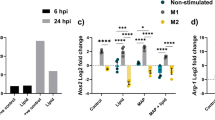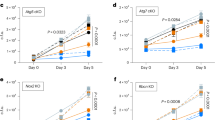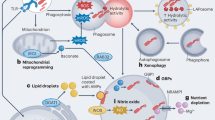Abstract
The evolutionary survival of Mycobacterium tuberculosis, the cause of human tuberculosis, depends on its ability to invade the host, replicate, and transmit infection. At its initial peripheral infection site in the distal lung airways, M. tuberculosis infects macrophages, which transport it to deeper tissues1. How mycobacteria survive in these broadly microbicidal cells is an important question. Here we show in mice and zebrafish that M. tuberculosis, and its close pathogenic relative Mycobacterium marinum, preferentially recruit and infect permissive macrophages while evading microbicidal ones. This immune evasion is accomplished by using cell-surface-associated phthiocerol dimycoceroserate (PDIM) lipids2 to mask underlying pathogen-associated molecular patterns (PAMPs). In the absence of PDIM, these PAMPs signal a Toll-like receptor (TLR)-dependent recruitment of macrophages that produce microbicidal reactive nitrogen species. Concordantly, the related phenolic glycolipids (PGLs)2 promote the recruitment of permissive macrophages through a host chemokine receptor 2 (CCR2)-mediated pathway. Thus, we have identified coordinated roles for PDIM, known to be essential for mycobacterial virulence3, and PGL, which (along with CCR2) is known to be associated with human tuberculosis4,5. Our findings also suggest an explanation for the longstanding observation that M. tuberculosis initiates infection in the relatively sterile environment of the lower respiratory tract, rather than in the upper respiratory tract, where resident microflora and inhaled environmental microbes may continually recruit microbicidal macrophages through TLR-dependent signalling.
This is a preview of subscription content, access via your institution
Access options
Subscribe to this journal
Receive 51 print issues and online access
$199.00 per year
only $3.90 per issue
Buy this article
- Purchase on SpringerLink
- Instant access to full article PDF
Prices may be subject to local taxes which are calculated during checkout





Similar content being viewed by others
References
Philips, J. A. & Ernst, J. D. Tuberculosis pathogenesis and immunity. Annu. Rev. Pathol. 7, 353–384 (2012)
Onwueme, K. C., Vos, C. J., Zurita, J., Ferreras, J. A. & Quadri, L. E. N. The dimycocerosate ester polyketide virulence factors of mycobacteria. Prog. Lipid Res. 44, 259–302 (2005)
Murry, J. P., Pandey, A. K., Sassetti, C. M. & Rubin, E. J. Phthiocerol dimycocerosate transport is required for resisting interferon-γ-independent immunity. J. Infect. Dis. 200, 774–782 (2009)
Flores-Villanueva, P. O. et al. A functional promoter polymorphism in monocyte chemoattractant protein-1 is associated with increased susceptibility to pulmonary tuberculosis. J. Exp. Med. 202, 1649–1658 (2005)
Reed, M. B. et al. A glycolipid of hypervirulent tuberculosis strains that inhibits the innate immune response. Nature 431, 84–87 (2004)
Medzhitov, R. Recognition of microorganisms and activation of the immune response. Nature 449, 819–826 (2007)
Weiser, J. N. The pneumococcus: why a commensal misbehaves. J. Mol. Med. 88, 97–102 (2010)
Yang, C.-T. et al. Neutrophils exert protection in the early tuberculous granuloma by oxidative killing of mycobacteria phagocytosed from infected macrophages. Cell Host Microbe 12, 301–312 (2012)
Mayer-Barber, K. D. et al. Cutting edge: caspase-1 independent IL-1 production is critical for host resistance to Mycobacterium tuberculosis and does not require TLR signaling in vivo. J. Immunol. 184, 3326–3330 (2010)
Ramakrishnan, L. Revisiting the role of the granuloma in tuberculosis. Nature Rev. Immunol. 12, 352–366 (2012)
Rosenthal, S. & Tager, I. B. Prevalence of Gram-negative rods in the normal pharyngeal flora. Ann. Intern. Med. 83, 355–357 (1975)
Wertheim, H. F. L. et al. The role of nasal carriage in Staphylococcus aureus infections. Lancet Infect. Dis. 5, 751–762 (2005)
Eddens, T. & Kolls, J. K. Host defenses against bacterial lower respiratory tract infection. Curr. Opin. Immunol. 24, 424–430 (2012)
de Mendonça-Lima, L. et al. The allele encoding the mycobacterial Erp protein affects lung disease in mice. Cell. Microbiol. 5, 65–73 (2003)
van der Vaart, M., van Soest, J. J., Spaink, H. P. & Meijer, A. H. Functional analysis of a zebrafish myd88 mutant identifies key transcriptional components of the innate immune system. Dis. Model. Mech. 6, 841–854 (2013)
Tobin, D. M. et al. The lta4h locus modulates susceptibility to mycobacterial infection in zebrafish and humans. Cell 140, 717–730 (2010)
Chan, J., Xing, Y., Magliozzo, R. S. & Bloom, B. R. Killing of virulent Mycobacterium tuberculosis by reactive nitrogen intermediates produced by activated murine macrophages. J. Exp. Med. 175, 1111–1122 (1992)
Kröncke, K. D., Fehsel, K. & Kolb-Bachofen, V. Inducible nitric oxide synthase in human diseases. Clin. Exp. Immunol. 113, 147–156 (1998)
Serbina, N. V., Jia, T., Hohl, T. M. & Pamer, E. G. Monocyte-mediated defense against microbialpathogens. Annu. Rev. Immunol. 26, 421–452 (2008)
Antonelli, L. R. V. et al. Intranasal Poly-IC treatment exacerbates tuberculosis in mice through the pulmonary recruitment of a pathogen-permissive monocyte/macrophage population. J. Clin. Invest. 120, 1674–1682 (2010)
Ordway, D. et al. The hypervirulent Mycobacterium tuberculosis strain HN878 induces a potent TH1 response followed by rapid down-regulation. J. Immunol. 179, 522–531 (2007)
Bates, J. H., Potts, W. E. & Lewis, M. Epidemiology of primary tuberculosis in an industrial school. N. Engl. J. Med. 272, 714–717 (1965)
Wells, W. F., Ratcliffe, H. L. & Grumb, C. On the mechanics of droplet nuclei infection; quantitative experimental air-borne tuberculosis in rabbits. Am. J. Hyg. 47, 11–28 (1948)
Sinsimer, D. et al. The phenolic glycolipid of Mycobacterium tuberculosis differentially modulates the early host cytokine response but does not in itself confer hypervirulence. Infect. Immun. 76, 3027–3036 (2008)
Scott, H. M. & Flynn, J. L. Mycobacterium tuberculosis in chemokine receptor 2-deficient mice: influence of dose on disease progression. Infect. Immun. 70, 5946–5954 (2002)
Feng, W. X. et al. CCL2−2518 (A/G) polymorphisms and tuberculosis susceptibility: a meta-analysis. Int. J. Tuberc. Lung Dis. 16, 150–156 (2012)
Gagneux, S. Variable host-pathogen compatibility in Mycobacterium tuberculosis. Proc. Natl Acad. Sci. USA 103, 2869–2873 (2006)
Charlson, E. S. et al. Topographical continuity of bacterial populations in the healthy human respiratory tract. Am. J. Respir. Crit. Care Med. 184, 957–963 (2011)
von Bernuth, H., Picard, C., Puel, A. & Casanova, J.-L. Experimental and natural infections in MyD88- and IRAK-4-deficient mice and humans. Eur. J. Immunol. 42, 3126–3135 (2012)
Comas, I. et al. Out-of-Africa migration and Neolithic coexpansion of Mycobacterium tuberculosis with modern humans. Nature Genet. 45, 1176–1182 (2013)
Cosma, C. L., Klein, K., Kim, R., Beery, D. & Ramakrishnan, L. Mycobacterium marinum Erp is a virulence determinant required for cell wall integrity and ntracellular survival. Infect. Immun. 74, 3125–3133 (2006)
Takaki, K., Cosma, C. L., Troll, M. A. & Ramakrishnan, L. An in vivo platform for rapid high-throughput antitubercular drug discovery. Cell Rep. 2, 175–184 (2012)
Brannon, M. K. et al. Pseudomonas aeruginosa Type III secretion system interacts with phagocytes to modulate systemic infection of zebrafish embryos. Cell. Microbiol. 11, 755–768 (2009)
Yu, J. et al. Both phthiocerol dimycocerosates and phenolic glycolipids are required for virulence of Mycobacterium marinum. Infect. Immun. 80, 1381–1389 (2012)
Takaki, K., Davis, J. M., Winglee, K. & Ramakrishnan, L. Evaluation of the pathogenesis and treatment of Mycobacterium marinum infection in zebrafish. Nature Protocols 8, 1114–1124 (2013)
Davis, J. M. & Ramakrishnan, L. The role of the granuloma in expansion and dissemination of early tuberculous infection. Cell 136, 37–49 (2009)
Clay, H. et al. Dichotomous role of the macrophage in early Mycobacterium marinum infection of the zebrafish. Cell Host Microbe 2, 29–39 (2007)
Lepiller, S. et al. Imaging of nitric oxide in a living vertebrate using a diaminofluorescein probe. Free Radic. Biol. Med. 43, 619–627 (2007)
Maruyama, I. N., Rakow, T. L. & Maruyama, H. I. cRACE: a simple method for identification of the 5′ end of mRNAs. Nucleic Acids Res. 23, 3796–3797 (1995)
Acknowledgements
We thank S. Falkow and P. Edelstein for sharing their knowledge and insights, P. Donald for discussions about human infectivity in tuberculosis, B. Cormack for manuscript review and editing, J. Bubeck-Wardenberg for the fluorescent S. aureus strain, K. Hicks for initial MyD88 experiments, T.-Y. Chen, B. Moody, P. Manzanillo and J. Cox for help with lipid analyses, and J. Cameron for fish facility management. Supported by a National Science Foundation predoctoral fellowship to C.J.C., a Senior Research Training Fellowship from the American Lung Association and the National Institutes of Health (NIH) Training Grant “Training Clinical and Basic Immunologists” to R.P.L., a NIH “Academic Pediatric Infectious Disease” Training Grant award to R.E.H., an American Cancer Society Postdoctoral Fellowship and NIH Bacterial Pathogenesis Training Grant Award to D.M.T., and NIH grants to K.B.U. and L.R. D.M.T. is a recipient of the NIH Director’s New Innovator Award and L.R. is a recipient of the NIH Director’s Pioneer Award.
Author information
Authors and Affiliations
Contributions
C.J.C., C.L.C., K.K.T., D.M.T., R.E.H. and L.R. conceived and designed M. marinum/zebrafish experiments and analysed data; C.J.C., C.L.C., K.K.T., D.M.T. and R.E.H. performed these experiments; R.P.L. and K.B.U. designed the M. tuberculosis/mouse experiments and analysed the data; R.P.L. performed the mouse experiments; C.J.C., C.L.C. and L.R. wrote the paper; C.J.C., R.P.L. and K.K.T. prepared the figures; and all authors edited the paper.
Corresponding author
Ethics declarations
Competing interests
The authors declare no competing financial interests.
Extended data figures and tables
Extended Data Figure 1 Coordinate use of PDIM-mediated immune evasion and PGL-mediated recruitment by pathogenic mycobacteria.
Models for infection with wild-type (WT) and PDIM-deficient mycobacteria are shown in the context of the relatively sterile lower airway versus the upper airway, with its higher levels of resident microflora and inhaled environmental organisms.
Extended Data Figure 2 ΔmmpL7 bacteria are attenuated in zebrafish larvae.
a, Kaplan–Meier graph showing daily survival of larvae infected via caudal vein injection with medium (mock), 29 wild-type or 70 ΔmmpL7 M. marinum. N = 25 (mock), 31 (wild-type), or 29 (ΔmmpL7) larvae per group. Mean time to death (days): mock (11), wild type (7.6) and ΔmmpL7 (11.2). Survival was compared by log-rank test: wild type versus mock and wild type versus ΔmmpL7, P < 0.0001; mock versus ΔmmpL7, P = 0.5601. b, c, Larvae were infected via caudal vein injection 1 dpf with 550 wild-type, 650 ΔmmpL7, or 700Δerp, fluorescent M. marinum. b, Infection burdens were measured by Fluorescent Pixel Count (FPC; mean ± s.e.m.). c, Representative images at 7 dpi. N = 29 (wild-type and ΔmmpL7) or 30 (Δerp) larvae per group. Scale bar, 500 μm. At 3, 5 and 7 dpi, log10 FPC was compared by ANOVA, with Dunnett’s post-test. ***P < 0.001. d, e, Representative images from wild-type (d) and ΔmmpL7 (e) M. marinum HBV infections quantified in Fig. 1d. N = 18 (wild-type) or 16 (ΔmmpL7) larvae per group. HBVs are outlined with a dashed white line. Scale bar, 100 µm.
Extended Data Figure 3 Knockdown of MyD88 results in a late, dose-dependent hypersusceptibility to M. marinum systemic infection.
a, RT–PCR for actin (top) and myd88 (bottom), demonstrating that that the majority of myd88 transcripts at 7 dpf are abnormal in MyD88 morphants. Lanes marked ‘b’ and ‘c’ correspond to morphants from the same experiments depicted in panels b and c, respectively. The abnormal larger transcript (indicated by an asterisk) results from the inclusion of intron 2 in the final transcript, incorporating a premature stop codon that truncates the protein before the TIR (Toll/interleukin receptor) domain. b, c, Caudal vein infection of MyD88 morphants with 141 (b) or 325 (c) c.f.u. M. marinum/larva. Bacterial burden was assessed by FPC, values plotted represent the mean ± s.e.m. Time points were compared by one-way ANOVA and Bonferroni’s post-tests. *** P < 0.001. d, Representative images of larvae at 5 dpi from experiment in c, N = 30 control, 15 MyD88 morphant. Scale bar, 500 μm.
Extended Data Figure 4 Characteristics of macrophages recruited to wild-type and PDIM-deficient bacteria.
a, Mean Mpeg1-positive macrophages recruited at 3 hpi into the HBV of wild-type fish after infection with 80 wild-type or ΔmmpL7 M. marinum. b, Data from Fig. 2c expressed as mean numbers of total infected macrophages and iNOS-expressing infected macrophages after HBV infection with 80 wild-type, ΔmmpL7, or Δerp M. marinum. c, Bacterial burdens after L-NAME treatment. Mean bacterial burdens of 2 dpf control (CTRL)- or iNOS inhibitor (L-NAME)-treated fish after HBV infection with 80 wild-type or ΔmmpL7 M. marinum. NS, not significant.
Extended Data Figure 5 Wild-type bacterial burdens after co-infection with wild-type or ΔmmpL7 bacteria.
Representative images from the HBV co-infections quantified in Fig. 2e. a, b, Red fluorescent wild-type (WT) M. marinum co-infected with green fluorescent wild-type (a) or ΔmmpL7 (b) M. marinum. N = 18 (wild-type) and 19 (ΔmmpL7) larvae per group. Scale bar, 50 µm. c, Wild-type bacterial burdens after co-infection with wild-type or ΔmmpL7 M. marinum with and without L-NAME treatment. Significance tested by one-way ANOVA with Bonferroni’s post-test for comparisons shown.
Extended Data Figure 6 MyD88-dependent macrophage recruitment occurs in response to PDIM deficiency rather than being due to loss of another MmpL7-exported product.
a, Mean macrophage recruitment at 3 hpi into the HBV of wild-type or MyD88-morphant (MO) larvae after infection with 80 Δmas M. marinum. Student’s unpaired t-test. b, Mean surviving bacterial volume of red fluorescent wild-type M. marinum (initial infection dose of 30–40 c.f.u.) when co-infected with 30–40 green fluorescent wild-type, ΔmmpL7 or Δmas M. marinum at 3 dpi. Representative of two separate experiments. Significance tested by one-way ANOVA with Tukey’s post-test.
Extended Data Figure 7 Gating strategy and isotype controls for iNOS staining of mouse lung.
a, Representative gating strategy for isolation of inflammatory monocytes. A dump channel containing anti-CD4, CD8 and CD11c was plotted against a channel exhibiting autofluorescence and also containing anti-Ly6G. Using these markers, T cell, dendritic cell, alveolar macrophage, and neutrophil cell populations were excluded from the double-negative gate. Inflammatory monocytes were identified within the double-negative population by their co-expression of Ly6C and CD11b. These cells were then evaluated for intracellular iNOS expression. a, N = 4 per group (Fig. 3a, b) or b, with isotype control antibodies, N = 4 per group.
Extended Data Figure 8 Specificity of CCL2-mediated macrophage recruitment in wild-type and CCR2-morphant larvae
a, Mean macrophage recruitment at 3 hpi into the HBV of control (ctrl), or CCR2-morphant (CCR2) larvae after injection of vehicle control (‘mock’; 0.1% BSA in PBS), human CCL2 (hCCL2), human CCL4 (hCCL4), or human CCL5 (hCCL5). b, c, Mean macrophage (b) and neutrophil (c) recruitment at 3 hpi into the HBV of control (CTRL), CCR2-morphant (CCR2), or MyD88-morphant (MyD88) larvae after injection of vehicle control (mock), murine CCL2 (mCCL2), human CCL2 (hCCL2), human IL-8 (hIL-8), or human LTB4 (hLTB4). Representative of three separate experiments. Significance assessed by one-way ANOVA with Bonferroni’s post-test for the comparisons shown. *P < 0.05; ***P < 0.001.
Extended Data Figure 9 Identification of zebrafish CCL2 orthologue.
a, mRNA levels of potential CCL2 orthologues (mean ± s.e.m. of four biological replicates) induced at 3 h after caudal vein infection of 2 dpf larvae with 250–300 wild-type M. marinum. These assays were performed on the same cDNA pools as the data presented in Fig. 4b. b, Mean macrophage recruitment at 3 hpi into the HBV of wild-type or CCL2 morphant (MO) fish following infection with 80 M. marinum. Representative of two separate experiments.
Extended Data Figure 10 Infectivity assay.
a, b, Representative 5 hpi images from Fig. 4d following HBV infection with one (a) or three (b) M. marinum. Scale bar, 100 µm. N values for fish represented in a and b (that is, those found to be infected with 1–3 bacteria) are presented in Fig. 4d (18, 22, 28, 28, 28, 28, 22, 22 for the respective conditions as specified in the figure). c, Mean bacterial burdens 5 h after HBV infection with 1–3 wild-type (WT), ΔmmpL7 or Δpks15 M. marinum.
Supplementary information
Supplementary Tables
This file contains Supplementary Table 1. (PDF 244 kb)
Mpeg1+ cells recruited towards WT Mycobacterium marinum
Red Mpeg1+ cells in the HBV, 1-9 hours post infection with wasabi-expressing WT M. marinum, imaged every three minutes. (MOV 10564 kb)
Mpeg1+ cells recruited towards ∆mmpL7 Mycobacterium marinum
Red Mpeg1+ cells in the HBV, 1-9 hours post infection with wasabi-expressing ∆mmpL7 M. marinum, imaged every three minutes. (MOV 10536 kb)
Rights and permissions
About this article
Cite this article
Cambier, C., Takaki, K., Larson, R. et al. Mycobacteria manipulate macrophage recruitment through coordinated use of membrane lipids. Nature 505, 218–222 (2014). https://doi.org/10.1038/nature12799
Received:
Accepted:
Published:
Issue Date:
DOI: https://doi.org/10.1038/nature12799
This article is cited by
-
Role of bacterial multidrug efflux pumps during infection
World Journal of Microbiology and Biotechnology (2024)
-
γδ T cells: origin and fate, subsets, diseases and immunotherapy
Signal Transduction and Targeted Therapy (2023)
-
Mycobacterium tuberculosis and its clever approaches to escape the deadly macrophage
World Journal of Microbiology and Biotechnology (2023)
-
Immune evasion and provocation by Mycobacterium tuberculosis
Nature Reviews Microbiology (2022)
-
Antibiotic resistance modifying ability of phytoextracts in anthrax biological agent Bacillus anthracis and emerging superbugs: a review of synergistic mechanisms
Annals of Clinical Microbiology and Antimicrobials (2021)



